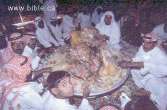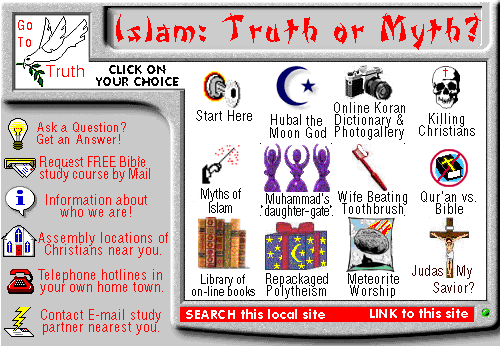Encyclopedia of Islamic Myths:
Animals were sacrificed at the Kabah at one time.
(adopted directly into Islam from pagan polytheism)
As shocking as it may be to Muslims, the "al-Hijr" (area enclosed by a half-moon shaped wall beside the Kaba called the hatim) was originally designed as a pen to house animals to be sacrificed at the Kaba. Like most other Islamic things, this odd structure was used for paganism before Muhammad came along and redefined its meaning. But this wall really serves no real purpose and is obviously the remnant of polytheistic worship of pagan gods. Today Muslims will say it is the grave of Ishmael, which is just another outrageous and unbelievable myth invented by Muhammad. Historically, no one before Muhammad every thought of this as the burial place of Ishmael.
|
Animals were sacrificed at the Kabah at one time. The hima was the holding pen for the animals. |

|
- "On one side of the Ka'bah is a semicircular wall, the extremities of which are in a line with the sides of the Ka'bah, and distant about six feet, leaving an opening which leads to the grave of Ishmael. 'The wall is called al-Hatim, " the broken," and the enclosed area al-Hijr, a the enclosure." (A Dictionary Of Islam, Thomas Patrick Hughes, 1965, Kaba, p 256)
- "The Hijr
Opposite the northwestern face of the Ka'ba is an area of special sanctity defined by a low semicircular wall (hatim). The area is called the hijr, and Muslim tradition identifies it as the burial place of Ishmael and Hagar.10 Not much is said of it in pre-Islamic times. The area first becomes prominent when Ibn al-Zubayr, a seventh-century Muslim ruler of Mecca, incorporated it into the Ka'ba by connecting the hatim to the building. His work was shortly undone, and the hatim was left a free-standing wall, as it is today. There are few plausible explanations of why there should be a wall there in the first place. It has been suggested, for example, that a low wall, and so the hijr enclosure, once surrounded the Ka'ba on all sides and marked the area within which the idols were worshiped through sacrifice, or, more enticingly but less convincingly, that the hatim represents the remains of the apse of a Christian church oriented toward Jerusalem, which, it will be seen, was the direction in which once Muhammad prayed while he was still at Mecca. The word hijr itself means "inviolable" or "taboo," and it occurs once in that sense in the Quran (6:137-139), in reference not to the area near the Ka'ba but to animals and crops earmarked as belonging to the gods, a sense that supports the contention that the hijr, whatever its original extent, may have served as a pen for the animals destined for sacrifice to the idols around the Ka'ba. Whether it was so used in Muhammad's own lifetime seems doubtful, however, at least on the evidence of the Muslim authorities. As the hijr is portrayed in Muhammad's day, it was a place of common assembly where political matters were discussed, or people prayed, or, as it appears, slept." (The Hajj, F. E. Peters, p 3-41, 1994)
- "II. The Religion of the Pre-Islamic Arabs The life of the pre-Islamic Arabs, especially in the Hijaz depended on trade and they made a trade of their religion as well. About four hundred years before the birth of Muhammad one Amr bin Lahyo bin Harath bin Amr ul-Qais bin Thalaba bin Azd bin Khalan bin Babalyun bin Saba, a descendant of Qahtan and king of Hijaz, had put an idol called Hubal on the roof of the Kaba. This was one of the chief deities of the Quraish before Islam. It is said that there were altogether three hundred and sixty idols in and about the Kaba and that each tribes had its own deity...The shapes and figures of the idols were also made according to the fancy of the worshippers. Thus Wadd was shaped like a man, Naila like a woman, so was Suwa. Yaghuth was made in the shape of lion, Yauq like a horse and Nasr like a vulture.. Besides Hubal, there was another idol called Shams placed on the roof of the Kaba...The blood of the sacrificial animals brought by the pilgrims was offered to the deities in the Kaba and sometimes even human beings were sacrificed and offered to the god... Besides idol-worship, they also worshipped the stars, the sun and the moon." (Muhammad The Holy Prophet, Hafiz Ghulam Sarwar (Pakistan), p 18-19, Muslim)
- "Al-Hijr. A similar development, I think, has occurred in the case of this term. At the Muslim sanctuary at Mecca the name al-Hijr designates the semi-circular area adjacent to the north-west wall of the Ka'ba. The area is regarded as of special sanctity, and the pilgrims perform the ritual circumambulations (tawdf) around the whole of the area covered by the Ka'ba and al-Hijr, not just around the Ka'ba.26 The special status of the Hijr is explained in Muslim tradition in a number of ways: at various, times it is said to have-been included in the Ka'ba, but ultimately its sanctity derives from its association with Hagar and Ishmael. Most frequently the hijr is explained as the place where Ishmael and his mother are buried.27 Modern scholarship has again concentrated on the question of the significance of the hijr in the religion of the Jahiliyya, rejecting the association with Ishmael and Hagar. Lammens argued that it was originally an independent pagan sanctuary which Islam subordinated to the Ka'ba, others have given it some place in the performance of sacrifices in or near the Ka'ba. Again, however, there are references to al-Hijr which suggest that it has changed in meaning. For example, there is mention of Quraysh meeting in al-Hijr in the Jahiliyya and in the lifetime of the Prophet, something which would hardly have been possible in the rather small area which now bears the name." (Studies On The First Century Of Islamic Society, Editor G.H.A. Juynboll, Chapter 2: The Origins of the Muslim Sanctuary at Mecca, G.R. Hawting, p23-48)
- Sometimes after these animals were marked, they remained with the herd, but very often as the special property of the god they were kept in a sacred enclosure (hima) near a sanctuary until their natural death. (Studies on Islam, edited by Merlin L. Swartz, Pre-Islamic Bedouin Religion, by Joseph Henninger, 1981, p 3-22)
- This leads us to mention briefly the individuals who played a special role in the religion. Can one speak of cultic officials? The priests (sadin, pl. sadana) mentioned in the Arabic sources" were not sacrificers but rather guardians of the sanctuaries, for each man was allowed to slaughter his own victim. The absence of a special class of priests recalls the primitive situation of the Semites and other shepherd nomads. (Studies on Islam, edited by Merlin L. Swartz, Pre-Islamic Bedouin Religion, by Joseph Henninger, 1981, p 3-22)
- More frequently mentioned are the sacrifices, bloody sacrifices as well as those that did not involve the shedding of blood. The animals which were immolated were the camel, the sheep, and the ox; fowl are never mentioned. (Studies on Islam, edited by Merlin L. Swartz, Pre-Islamic Bedouin Religion, by Joseph Henninger, 1981, p 3-22)
Written by Brother Andrew

Go To Start: WWW.BIBLE.CA
